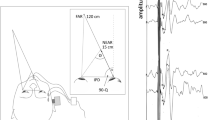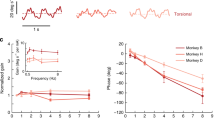Abstract
A theoretical analysis of two models of the vestibulo-ocular and optokinetic systems was performed. Each model contains a filter element in the vestibular periphery to account for peripheral adaptation, and a filter element in the central vestibulooptokinetic circuit to account for central adaptation. Both models account for1 adaptation, i.e. a response decay to a constant angular acceleration input, in both peripheral vestibular afferent and vestibulo-ocular reflex (VOR) responses and2 the reversal phases of optokinetic after-nystagmus (OKAN) and the VOR and3 oscillatory behavior such as periodic alternating nystagmus. The two models differ regarding the order of their VOR transfer function. Also, they predict different OKAN patterns following a prolonged optokinetic stimulus. These models have behavioral implications and suggest future experiments.
Similar content being viewed by others
References
Aschan G, Bergstedt M (1955) The genesis of secondary nystagmus induced by vestibular stimuli. Acta Soc Med Upsaliensis 60:113–122
Baertschi AJ, Johnson RN, Hanna GR (1975) A theoretical and experimental determination of vestibular dynamics in caloric stimulation. Biol Cybern 20:175–186
Baloh RW, Honrubia V, Konrad HR (1976) Periodic alternating nystagmus. Brain 99:11–26
Blanks RHI, Estes MS, Markham CH (1975) Physiologic characteristics of vestibular first order canal neurons in the cat. II. Response to constant angular acceleration. J Neurophysiol 38:1250–1268
Bock O, Koschitzky HV, Zangemeister WH (1979) Vestibular adaptation to long-term stimuli. Biol Cybern 33:77–79
Boumans LJJM, Rodenburg M, Maas AJJ (1983) Response of the human vestibulo-ocular reflex system to constant angular acceleration. II. Experimental investigation. ORL 45:130–142
Brandt TH, Dichgans J, Buchele W (1974) Motion habituation: Inverted self-motion perception and optokinetic afternystagmus. Exp Brain Res 21:337–352
Brown JH, Wolfe JW (1969) Adaptation to prolonged constant angular acceleration. Acta Otolaryngol 67:389–398
Büttner UW, Waespe W, Kenn V (1976) Duration and direction of optokinetic after-nystagmus as a function of stimulus exposure time in the monkey. Arch Psychiatr Nervenkr 222:281–291
Büttner UW, Henn V, Young LR (1981) Frequency response of the vestibulo-ocular reflex (VOR) in the monkey. Aviat Space Environ Med 52:73–77
Goldberg JM, Fernandez C (1971) Physiology of peripheral neurons innervating semicircular canals of the squirrel monkey. I. Resting discharge and response to constant angular accelerations. J Neurophysiol 34:635–660
Hood JD (1981) Further observations on the phenomenon of rebound nystagmus. Ann NY Acad Sci 374:532–539
Hostetter GH, Savanl CJ, Stefani RT (1982) Design of feedback control systems. Holt, Rinehart, and Winston, New York
Jeannerod M, Magnin M, Schmid R, Stefanelli M (1975) Vestibular habituation to angular velocity steps in the cat. Biol Cybern 22:39–48
Jung R, Kornhuber HH (1964) Results of electronystagmography in man: the value of optokinetic, vestibular, and spontaneous nystagmus for neurologic diagnosis and research. In: Bender MB (eds) The oculomotor system. Harper and Row, New York, pp 428–488
Koerner F, Schiller PH (1972) The optokinetic response under open and closed loop conditions in the monkey. Exp Brain Res 14:318–330
Leigh RJ, Robinson DA, Zee DS (1981) A hypothetical explanation for periodic alternating nystagmus: instability in the optokinetic-vestibular system. Ann NY Acad Sci 374:619–635
Maioli C (1988) Optokinetic nystagmus: modeling the velocity storage mechanism. J Neurosci 8:821–832
Malcolm R, Jones GM (1970) A quantitative study of vestibular adaptation in humans. Acta Otolaryngol 70:126–135
Paige GD (1983a) Vestibuloocular reflex and its interactions with visual following mechanisms in the squirrel monkey. I. Response characteristics in normal animals. J Neurophysiol 49:134–151
Paige GD (1983b) Vestibuloocular reflex and its interactions with visual following mechanisms in the squirrel monkey. II. Response characteristics and plasticity following unilateral inactivation of horizontal canal. J Neurophysiol 49:152–168
Raphan T, Cohen B, Matsuo V (1977) A velocity storage mechanism responsible for optokinetic nystagmus (OKN), optokinetic after-nystagmus (OKAN) and vestibular nystagmus. In: Baker R, Berthoz A (eds) Control of gaze by brain stem neurons. Elsevier/North-Holland Biomedical Press, New York
Robinson DA (1977) Vestibular and optokinetic symbiosis: an example of explaining by modelling. In: Baker R, Berthoz A (eds) Control of gaze by brain stem neurons. Elsevier/North-Holland Biomedical Press, New York
Robinson DA (1981) The use of control systems analysis in the neurophysiology of eye movements. Ann Rev Neurosci 4:463–503
Schmid R, Stefanelli M, Mira E (1971) Mathematical modelling. A contribution to clinical vestibular analysis. Acta Otolaryngol 72:292–302
Sills AW, Honrubia V, Baloh RW (1978) Is the adaptation model a valid description of the vestibulo-ocular reflex? Biol Cybern 30:209–220
Waespe W, Henn V (1977a) Neuronal activity in the vestibular nuclei of the alert monkey during vestibular and optokinetic stimulation. Exp Brain Res 27:523–538
Waespe W, Henn V (1977b) Vestibular nuclei activity during optokinetic after-nystagmus (OKAN) in the alert monkey. Exp Brain Res 30:323–330
Waespe W, Henn V (1978) Reciprocal changes in primary and secondary optokinetic after-nystagmus (OKAN) produced by repetitive optokinetic stimulation in the monkey. Arch Psychiatr Nervenkr 225:23–30
Waespe W, Huber Th, Henn V (1978) Dynamic changes of optokinetic after-nystagmus (OKAN) caused by brief visual fixation periods in monkey and in man. Arch Psychiatr Nervenkr 226:1–10
Wilson VJ, Jones GM (1979) Mammalian vestibular physiology. Plenum Press, New York
Young LR, Oman CM (1969) Model for vestibular adaptation to horizontal rotation. Aerosp Med 40:1076–1080
Zee DS, Yee RD, Robinson DA (1976) Optohiuetic responses in labyrintline-defective human beings. Brain Res 113:423–428
Author information
Authors and Affiliations
Rights and permissions
About this article
Cite this article
Furman, J.M.R., Hain, T.C. & Paige, G.D. Central adaptation models of the vestibulo-ocular and optokinetic systems. Biol. Cybern. 61, 255–264 (1989). https://doi.org/10.1007/BF00203172
Received:
Accepted:
Issue Date:
DOI: https://doi.org/10.1007/BF00203172




